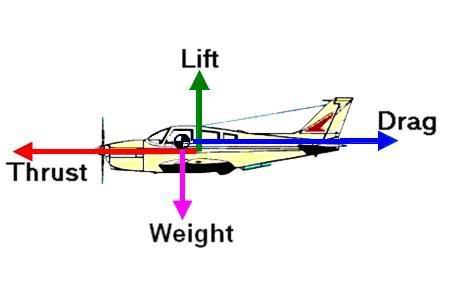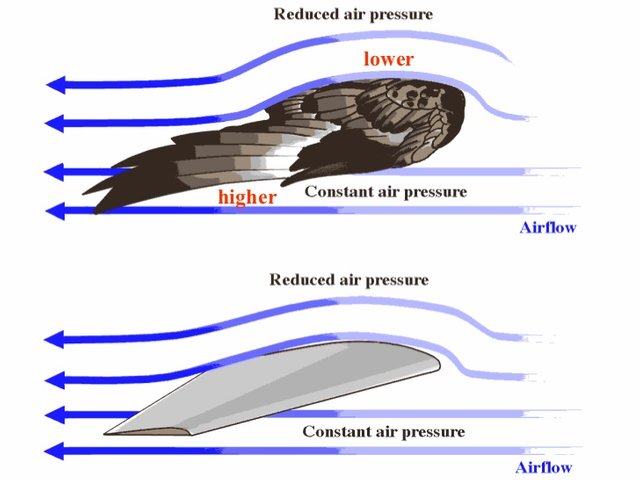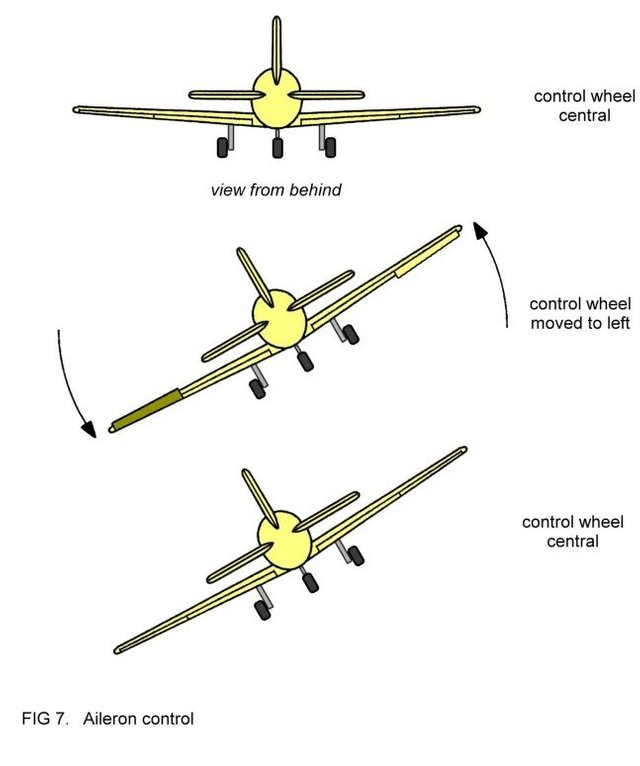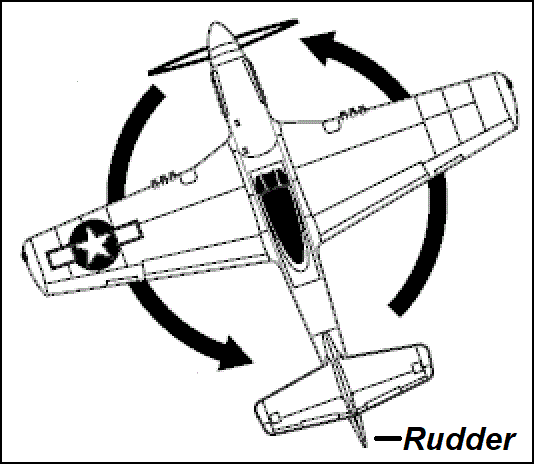The Physics of Aircraft Design and Flight
Whether you are flying a Cessna Skylane or an Airbus A380, the physics of aircraft design and flight remain the same. Those physics do not change based on the design, size, length, weight, wingspan, or number of passengers an aircraft can carry. The same basic rules apply. Obviously they have to be adjusted for each aircraft design (You can't expect a Cessna Skylane engine to power an A380!). In this article I will go over those principles of flight and aircraft design.
There are four forces that act on an aircraft during flight:
- Lift - The amount of lift created by the wings
- Weight - The amount of weight you intend to get airborne
- Thrust - The force that propels the vehicle forward whether that be a propeller or jet engine or variation of the two (i.e. - turbine powered prop)
- Drag - The effect of surfaces with respect to airflow. The more drag you introduce, the harder it is for an aircraft to pass through the air, reducing it's speed requiring more thrust to maintain speed.
The profile of the wing is responsible for creating lift. In all aircraft, the wings are curved along the top and flatter along the bottom. This is illustrated in the graphic below:
Air flowing over the bottom of the wing's surface flows faster than air flowing over the top of the wing's surface. This creates an area of low pressure above the wing. Since physics dictates that objects will tend to move away from high pressure and towards low pressure, lift is created. The speed at which the air travels over the wing is dictated by the speed the vehicle is moving. This brings us to thrust. Thrust is the force that pushes an aircraft forward. The more thrust compared to weight, the faster the aircraft will increase it's speed or accelerate. Now if all we plan to do is start flying at a specific altitude in a specific direction at a specific speed this is all you need to maintain flight. Unfortunately, aircraft do not operate this way. They have to takeoff, climb, bank, turn, and pitch up or down to achieve control of what the aircraft can do. Which brings us to the next topic of flight: Control Surfaces and their effect.
Control surfaces of an aircraft and their effect:
Most modern aircraft contain these basic control surfaces to achieve and maintain flight. They are pitch, bank, thrust, and yaw as well as drag.
Pitch - Pitch is described as the ability to control the forward up and down motion of aircraft in relation to the tail. This is demonstrated in the graphic below:
Now it is a common misconception that the pitch of the aircraft controls lift. To a small degree it does, but a very small degree. The pitch of an aircraft is used to control the speed of the aircraft. If an aircraft is in a pitch up configuration, with no forward power being applied, it will tend to slow down. If the pitch is in a nose down configuration with no forward power being applied, the aircraft will speed up. This is an important concept to remember as the most common mistake made by new pilots is to "pull the nose up" to climb faster. this will only slow you down after an initial brief period of climb.
Thrust - thrust is the power provided to push the aircraft through the air. Remember, the more airflow over the wings, the more lift is created as the air pressure becomes lower above the wings vs below them. Now a common misconception is that thrust controls speed, and to some extent it does, but only a small amount. Thrust primarily provides the lift to climb to higher altitude. So if you were flying towards a mountain and you have lots of time to make adjustments, it is thrust that would be increased to force the aircraft to climb higher to get over the mountain.
Of course aircraft don't just go up and down. If that were the case, it would be very difficult to take off heading west to a destination east of you. You would have to completely fly around the world at the exact heading without any deviation whatsoever to get to your destination and you had better hope your runway is in the direction you are flying.
This brings us to control surfaces. These consist primarily of ailerons, elevators, rudder and engine thrust. By combining these control surfaces, we can achieve controlled flight. There is also an additional component called yaw, but we'll get to that a bit later.
Ailerons - These are control surfaces located on the trailing edge of the outside of a wing to control the bank of the aircraft. That is - how much angle compared to the horizon is applied to the aircraft. if the right aileron is up and the left aileron is down, the aircraft will tilt to the left. Vise versa, if the left one is up and the right one is down, the aircraft will tilt to the right.
Elevators - Although the term elevator brings to mind lift (after all we use elevators to get from one floor to a higher floor of a building), they are actually used to control the pitch. That is, the angle of the nose as compared to the tail. if the elevators are up, the aircraft nose will pitch up and if down, the nose will angle down compared to the tail. Now I know I've used this graphic earlier but I didn't explain how the pitch is controlled.
Rudder - In a laboratory perfect environment with no gravity, the rudder would simply be your "steering wheel", similar to that used in a ship. it is used to control the turning of an aircraft. Unfortunately we don't fly in a gravity free environment so the rudder is used in combination with the ailerons to turn the aircraft, while banking using the ailerons, the rudder is turned to force the aircraft to turn in the direction desired. The rudder is usually controlled by foot pedals on the floor in front of the pilot.
Yaw - I know you're probably thinking this guy is in the early stages of Alzheimer's disease as he used the same graphic for rudder. Well it turns out (pun intended) that if you turn the rudder without the ailerons you produce yaw. Yaw is a term used to describe an aircraft's ability to have the nose of the aircraft off centerline from the tail. Used mainly to counter-act crosswinds during landing and takeoff, you will see yaw in action when an aircraft is coming in for a landing in windy conditions and he appears to be crooked to his direction of travel. In the very short video below, you'll see the effects of using the rudder to induce yaw.
Now some people may be asking, "What would be the use of ailerons without a rudder. The answer is simple. if you've ever seen a fighter jet do a barrel roll, he is using ailerons without rudder. As you can see in the video below, the pilot is using ailerons without rudder.
Flaps - These are trailing edge areas usually on the inboard of the wing used during takeoff and landing and they have several purposes in aircraft control. During low speed flight, such as takeoff and landing, the aircraft requires a larger wing surface area than it does during normal cruise. Since we don't have the option of replacing the wings mid-flight, we can extend the flaps to increase the surface area of the wings to produce more lift. Flaps also reduce stall speed (the minimum speed an aircraft can fly while maintaining flight). An added effect of flaps is the ability to reduce the pitch of an aircraft during landing. This is especially important in larger commercial jets where the pilots would not be able to see the runway if the nose of the aircraft were too high. By applying flaps, the pitch of the aircraft is reduced at lower speeds allowing the pilot to properly line up with the runway.
I hope this article gives you a basic understanding of the principles used in flight. I look forward to reading your comments and answering any questions you may have. If you found this article useful, I would appreciate an upvote. Thanks.
Image Sources:
Figure 1. - activelabz.files.wordpress.com/2012/02/aerodynamic-force.jpg
Figure 2. - s-media-cache-ak0.pinimg.com/originals/82/2a/53/822a539295f8a14336d0becc0ab6de8a.gif
Figure 3. - bmfa.org/portals/0/Images/Getting%20Started/pitch.gif
Figure 4. - steemrok.com/howdo%20click/howdo%20fig%207.jpg
Figure 5. - bmfa.org/portals/0/Images/Getting%20Started/pitch.gif
Figure 6. - aviastar.org/theory/basics_of_flight/yaw.gif
Figure 7. - aviastar.org/theory/basics_of_flight/yaw.gif






Hi, your article has been featured in the Physics-Trail Magazine N.3!
Please take a look and appreciate any comments. Thanks!
I actually taught maths to a couple of pilots some years ago - was interesting to see what they needed.
Cool introduction to the principles of flight! In-depth and simple to understand!
(Upvoted and Followed. Follow me back for science/tech/crypto related posts!)
Hey man,
nice to see someone explaining the basic principles of fight.
im thinking about nominating the post in a curation group im in
we like to see sources for pictures though(give credit where credit is due;)). And I think you know how important sources are especially in scientific texts
There ya go. Found the sources. :)
haha great
was also meant more of an incentive for new posts ;)
The group is @ocd ill probably nominate you for saturdays compilation and then we will see if the others like it aswell
edit: ups meant to say Sundays sorry
Honestly, I just googled the topic in question until I found a suitable image. I'd probably never find the same image again. :P
Hey, have you already discovered steemSTEM? If not, I invite you to check out the #steemSTEM channel on steemit.chat, it's where the science community of steemit gathers :)
This is incredible stuff right here. Might have to use it in our flying car research ;)
I had a friend that told me once that air-flight is compromised of 10% engineering and 90% magic. Nobody knows the exact physics why a plane flies the way it does. Is more like estimations and propability.
He is a fighting jet pilot.
very good article and very clear the explanation very easy to understand, I like because we can do a lot of things just knowing the basis of the physics present there.
hi technerd, i am searching some post aircraft and i nailed it. i am lover aircraft. i would like know if you can review my post about my experience in a student gripu called Aerodesign SAE USB. we create a prototype aircraf. I will be talking abou it. Regards